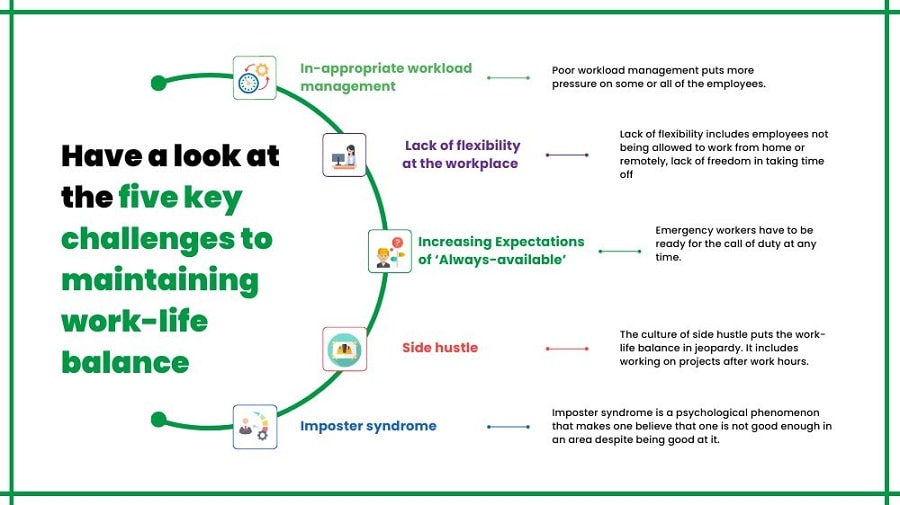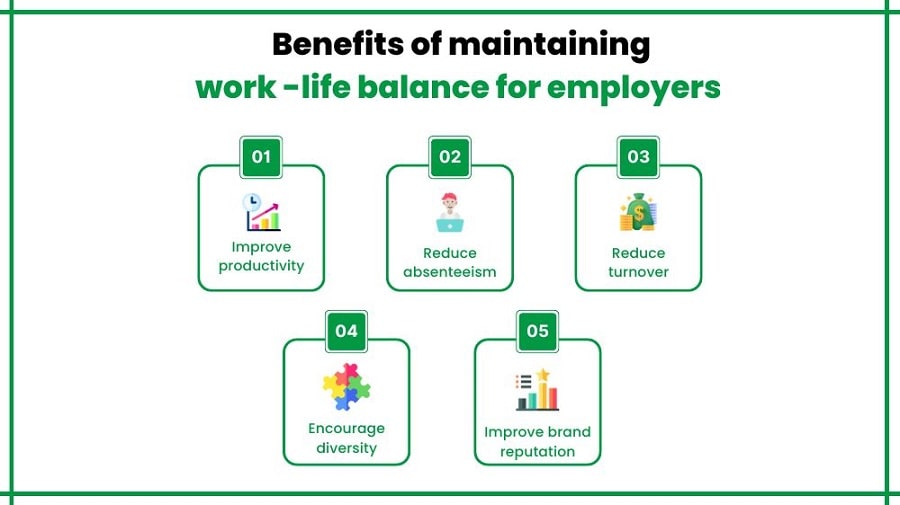A great work-life balance ensures your employees are more productive, focused, and engaged, have good personal mental and physical well-being, and are satisfied with their both personal and professional life. This shows work-life balance has a direct relation to how effectively your employees work.
A recent survey of 83% of Fortune 1000 companies also confirmed that “Employees who felt in control of their work-life balance effectively worked harder than employees who lacked this level of comfort.”
For decades, industry leaders have been looking for effective solutions to maintain work-life balance for their workforce yet a significant portion of the global workforce experience burnout, work-related stress, and now, pressure to be always available too – in the era of working from home!
According to the newly released report, more than half (59%) of American workers are experiencing at least moderate levels of burnout in 2022 due to poor work-life balance.
Thus, if your workforce is also facing work-life balance challenges, you are not alone.
The Bright Side is that we have a decent percentage of the workforce who has great life balance and they are quite happy with their employer. You can also ensure the work-life balance for your workforce by adopting the right measures.
In this post, we will talk about the challenges which come while maintaining work-life balance, strategies for maintaining work-life balance, how work-life balance can benefit your organization, and more.
Let’s learn together!
Challenges while maintaining work-life balance at the workplace
Employees face a variety of challenges in maintaining work-life balance at the workplace. Some are within your control while some are out of your control.
For example, poor workload management for a long time can result in poor work-life balance as some employees have to work long hours to meet deadlines and expectations. You or your manager can fix that with skillful workload management.
On the other hand, if your employees are indulging in side hustle after office hours or have relationship issues in their personal lives, you cannot help them much apart from providing guidance and support.
Have a look at the five key challenges to maintaining work-life balance

1. In-appropriate workload management
Poor workload management puts more pressure on some or all of the employees. It leads to long working hours or employees clocking at home after work hours, increasing expectations to meet the unrealistic KPIs or targets, and some employees being overworked while others are underworked.
This can result in decreased productivity and satisfaction as employees are not able to take time off to relax.
Especially for knowledge work, the mental and physical well-being of an employee plays a crucial role in optimal brain function.
2. Lack of flexibility at the workplace
Many times organizations are prone to this without knowing much about it. Lack of flexibility includes employees not being allowed to work from home or remotely, lack of freedom in taking time off, no flexible working hours, less space to take regular breaks during working hours due to high work pressure, and more. This can result in dissatisfied employees due to a lack of convenience and not enough time to relax.
3. Increasing expectations of ‘always-available’
There are various verticals where expectations of being ‘always on’ are always present, for eg. emergency services. Emergency workers have to be ready for the call of duty at any time. But in most industries, it can be avoided or managed to the best possible extent by ensuring work-life balance.
Also, the evolving tech has contributed to ‘always-available’ expectations. For example, employees are logged in to their personal phones on workplace apps like Gmail, Google Chat, or Slack. They can easily get clocked to work mode by the work notifications while enjoying weekend turkey at the dinner table with their family.
This blurs the boundary between personal and professional life where employees do not know what is the point of relaxation. The work-life integration does not allow employees to take a break from work which makes them feel exhausted and burnt out.
4. Side hustle
The culture of side hustle puts the work-life balance in jeopardy. It includes working on projects after work hours. There are some employees for whom work is their passion or they draw satisfaction from the work, but if it becomes a culture, it is hard to ensure the work-life balance.
Side hustle culture comes with a lot of benefits such as one can enhance and sharpen one’s skills, earn some income, or even build a dedicated freelancing career. But, it has a direct impact on work-life balance, mental and physical well-being, productivity, and involvement in the workplace.
5. Imposter syndrome
Imposter syndrome is a psychological phenomenon that makes one believe that one is not good enough in an area despite being good at it. It is a state of self-doubt where employees fear failure or believe their success is not deserved. They feel that they are tricking others and they are about to be exposed.
In order to compensate for that, they work hard. This consistent sense of job insecurity puts work-life balance at stake. Employees remain in stress, not able to take their minds off of work which eventually impacts productivity and quality at the workplace.
Strategies for maintaining work-life balance
Leaders have a great influence over the decisions employees make. You can set up workplace policies, guide and encourage the employees, and take decisions that promote and ensure work-life balance. It boosts employee happiness and satisfaction which results in lower stress levels – that eventually makes your employees more productive — benefiting your business.
1. Start with workload management

Most employees experience workplace exhaustion due to high work pressure for a long time. You can simply start by reviewing workload management. Find out which employees are busy and overworked and which have capacity. Redistribute the workload accordingly.
If you need more resources, arrange them, but do not overstress your existing employees with unrealistic workloads. This shows your employees you think about them and take care of them.
A good manager should talk and listen to a team from time to time to ensure individuals have achievable workloads.
Want to make workload management easy? Check out 10 Best Product Management Tools for 2023!
2. Set up a good workplace culture

It is entirely in your hands to set up a good workplace culture. For example, you can lead from the front by:
- Making a norm that no one sits in the office after their working hours
- Ensuring managers and employees are not asking each other to provide updates once they are home
- Providing the maximum freedom in clock-off time to employees as you can
- Simply recognize and appreciate the employees who have a good work-life balance
- Focus on productivity rather than hours. You can encourage employees to follow the concept of Pomodoro if possible. (The Pomodoro Technique is a time management method based on 25-minute stretches of focused work broken by five-minute breaks.)
This helps reduce workplace stress, drops absenteeism, and provides employees with a clear distinction between time off and time working.
3. Offers flexibility in terms of remote working and working hours
87% of respondents in the third edition of McKinsey’s American Opportunity Survey say they will take the chance to work flexibly if offered. Flexible working includes remote work, hybrid work, and part-time work, and flexible working hours mean giving freedom to the employees to manage their own time in a way they find suitable.
For example, if an employee wants to visit a physician, they can get free earlier or shift the working hours, and make an appointment without taking a paid leave. This increased convenience enhances overall satisfaction of the job and makes your employees happy.
4. Regular breaks are welcomed
It’s not about the hours spent. It’s about the number of focused hours spent.
What would you choose — a focused session of 1-1.5 hours followed by a 15-minute break or dragging the time for 2 hours without any break?
The answer is clear!
Encourage your employees to take regular breaks. It is good for their mental and physical well-being and for optimal brain function too. Knowledge work requires optimal brain function and optimal brain function depends on physical and emotional well-being.
5. Encourage employees to take time off

Some may or may not agree with the advantages of regular breaks, but we all agree with the advantages of taking some time off. Spend some time with family and friends.
If you are seeing an employee not taking annual leave, encourage them to take time off. It will help them take some time off, relax, rejuvenate – and return to work motivated, rejuvenated, and refreshed. 😃
6. Offer perks
Surveys have shown that C-level executives believe employee perks work, but more than 50% of employees think they do not work. Here is a trick in that — what kind of perks you are providing matters the most.
Another thing is first you should get the basics right like an employee would appreciate ergonomic furniture more at the workplace than a ping pong table. So, invest smartly.
Rather than investing a big deal in unnecessary things, invest in something that matters to employees.
For example, you can give your employee a free fitness class in a week rather than focusing on playing office games. Or real benefits like health insurance would work great.
This sends a direct message to your employee that you care about their emotional, physical, and mental well-being.
7. Lead by an example

As we discussed earlier, you are in a position of influence. You may act as an example for many beginners and even experienced at your workplace. If you are not having the right work-life balance or not adopting actionable policies promoting employees’ work-life balance, it is hard to ensure work-life balance.
Led by example. Recognize and appreciate employees who have achieved a good work-life balance.
If you have a small team, connect with your team from time to time. Feeling heard and connected to a leader can give your employees the assurance nothing else can provide.
8. Leave the door open for communication

It is hard to talk about the work-life balance without open communication between the team and management. If employees are facing challenges, you need to ask and listen to their views.
Develop a culture in your organization where open communication is cherished and anyone can go to the manager’s office for concerns. This will help get direct insights into the challenges your workforce is struggling with and probable measures you can adopt to address them.
9. Provide help, support, and resources

94% of employees feel that the mental health training support they received in the workplace is effective. Help and support your employees in the challenges they are facing. They cannot be the same for every organization.
For example, if you have a lot of parents in your workforce, you have to create policies in a way keeping them in mind. On the other hand, if you have more GenZ in your workforce, you have to create policies and support channels keeping them in mind.
Benefits of maintaining work-life balance

Many managers think work-life balance it’s just related to employees’ well-being, but it also takes care of the employer’s well-being. Most simply, work-life balance improves employees’ mental and physical health, boosts productivity, and reduces employees’ turnover rate. This in turn leads to a wide range of benefits.
Benefits of maintaining work-life balance for employers:
- Improve productivity: When employees are satisfied with their personal life, they tend to focus more on the work. This improved focus and motivation in work boosts productivity.
- Reduce absenteeism: When employees are happy with their work-life balance, they want to come to the office. This reduces absenteeism and improves work engagement.
- Reduce turnover: Happy employees stay longer. A good work-life balance reduces turnover as employees are satisfied with their job. This helps you save time, effort, and money on hiring new talent.
- Encourage diversity: According to Harvard Business Review, black women are nearly twice as likely as white women to have quit a job or refused a job offer because of childcare problems. Flexible working encourages diversity in the workplace.
- Improve brand reputation: Good work-life balance is cherished by everyone. 72% of workers believe work-life balance is a very important factor when choosing a job. Thus, it can help you attract top talent among potential recruiters.
Understand the difference between convenience and work-life balance
Many people confuse convenience with work-life balance. A popular example of that is work-life integration where employees are working from home remotely. It is a convenient mode of work as they can run a quick errand without the permission of anyone or they are near to their family or they may attend an appointment during the day.
But, it is not a work-life balance. Studies show that remote employees often work for more hours than people who work in an office. It is a ‘convenience’ not ‘balance.’
Work-life balance is when you have a balanced life with work. You are not getting interrupted by work or thinking of work when living your personal life. So, it is very important to fix the meaning of work-life balance.
Just informing, giving equal time to work and personal life is also not a work-life balance. Work-life balance is a pleasurable camaraderie between work and life.
For a reference point,
- Working 38 hours per week produces the happiest employees
- Working 40 hours per week is the work-life balance
- Working more than 45 hours per week is detrimental to both physical and mental health.
- Working 50 hours per week declines productivity per hour
- Working 55 hours per week is pointless
How you as a manager or leader can help?
Managers or team leads are usually the first points of contact for team members in case they are seeking a resort from something or need a solution for the challenges they are facing. Thus, managers play a key role in ensuring work-life balance for their workforce.
We agree work-life balance is an area that requires the equal participation of both employees and management to achieve fruitful results, but managers can play the role of influencer here:
- Help employees understand the importance of work-life balance
- Encourage employees to adopt work-life balance in life
- Hear the concerns of employees and provide a reference for the top management to act based on the feedback received
- Help top management craft policies that promote the work-life balance at the workplace
- Lead an example to influence employees to have a good work-life balance
If you want to share your thought with others on work-life balance, you can comment below in the comments section. Or you can share what else managers or leaders can do to ensure work-life balance for their employees.
For more such useful information, you can read our following blogs:




















No Comments